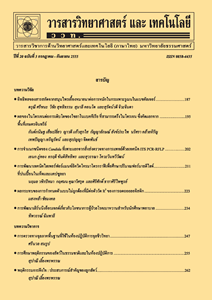บทบาทของยีน MATE1 ต่อการเกิดภาวะเลือดเป็นกรดจากยา metformin ในผู้ป่วยเบาหวานชนิดที่ 2
Main Article Content
Abstract
บทคัดย่อ
Metformin เป็นยาตัวแรกที่ถูกแนะนำให้ใช้รักษาโรคเบาหวานชนิดที่ 2 เนื่องจากมีประสิทธิภาพในการลดระดับน้ำตาล มีผลข้างเคียงเรื่องน้ำตาลต่ำน้อย ไม่มีผลต่อการเพิ่มน้ำหนัก ราคาถูก ยาสามารถลดระดับน้ำตาลในเลือดโดยลดระดับน้ำตาลจากตับ และเพิ่มการใช้นำน้ำตาลไปใช้ของเนื้อเยื่อของร่างกาย ผลข้างเคียงของยา metformin ที่สำคัญคือภาวะเลือดเป็นกรด โดยตรวจพบกรดแลคติก (lactic acid) ในเลือดปริมาณสูงตั้งแต่ 5mM ขึ้นไปและมี่ค่าความเป็นกรดในเลือด (pH) น้อยกว่าหรือเท่ากับ 7.35 ซึ่งภาวะแทรกซ้อนนี้พบได้ประมาณ 6.3 รายต่อ 100,000 ผู้ป่วยต่อปี ผู้ป่วยส่วนใหญ่มักมีอาการรุนแรงและจำเป็นต้องได้รับการรักษาด้วยการฟอกเลือดฉุกเฉินเพื่อแก้สมดุลกรด-ด่างพร้อมการให้ยา sodium bicarbonate และให้การรักษาปัจจัยอื่นที่สนับสนุนให้เกิดอาการนี้ สาเหตุของการเกิดภาวะเลือดเป็นกรดส่วนหนึ่งมาจากการที่ผู้ป่วยมีปัจจัยส่งเสริมให้เกิดโรค ได้แก่ ภาวะไตวาย ตับวาย ภาวะติดสุราหรือมีการไหลเวียนขอเลือดในเนื้อเยื่อลดลง ได้แก่ ติดเชื้อรุนแรง หัวใจล้มเหลว และอาจมีปัจจัยอื่น ๆ จากผู้ป่วยร่วมด้วย จากการศึกษาที่ผ่านมาพบว่าบางรายเกิดภาวะนี้ได้ง่ายกว่าผู้ป่วยอีกกลุ่มหนึ่งทั้งที่มีลักษณะทางกายภาพไม่แตกต่างกัน จึงเป็นไปได้ว่าอาจมีกลไกบางอย่างในการกำจัดยา metformin เกิดบกพร่อง จนทำให้เกิดภาวะนี้ได้ง่าย มีสมมุติฐานจากงานวิจัยพบว่าความแตกต่างทางพันธุกรรมของยีน MATE/SLC47 (gene polymorphism) ทำให้กลไกการกำจัดของยาจากไตบกพร่อง และอาจเป็นเหตุทำให้เกิดภาวะเลือดเป็นกรด
คำสำคัญ : เลือดเป็นกรดจากการใช้ยา; เมทฟอร์มิน; โปรตีนขนส่งผิวเซลล์
Abstract
Metformin is recommended to be the first line treatment of type 2 diabetes due to high efficacy, low cost, low risk of hypoglycemia and no weight gain, which are highly valued advantages. Recent studies, established that metformin, result in a significant decrease in the production of hepatic glucose. Additionally, metformin results in glucose utilization in peripheral tissue. Consequently the two effects combined result in a dramatic reduction of glucose level. Metformin associated metabolic acidosis (MALA) is a fatal adverse effect in patient treated with metformin. MALA defined by blood lactate of more than 2mmol/L, pH less than 7.35 in metformin treated patients. Incidences of lactic acidosis occurring as a result of metformin treatment, is at a rate of 6.4 patients per 100,000, year on year. Well established predisposing factors for MALA are due to a variety of reasons. Namely, impaired renal function, concurrent liver disease, alcoholism, and decreased tissue perfusion due to infection, heart failure or other causes. The majority of patients demonstrated severe conditions and needed hemodialysis treatment in some case. Conventional wisdom has it that the association between metformin and lactic acidosis suggests is directly of causally linked with renal failure and that other factors such as sepsis or cardiac failure. However some researches has established an additional link the patient factor itself. Indeed the polymorphism of the MATE/SLC47 gene, affecting the accumulation and/or elimination of metformin, also suggests the potential for the cause of metformin associated lactic acidosis (MALA).
Keywords: metformin associated metabolic acidosis (MALA); metformin; membrane transporter; MATE-1; SLC47A1


